Wildlife and Conservation: Native Woody Plants
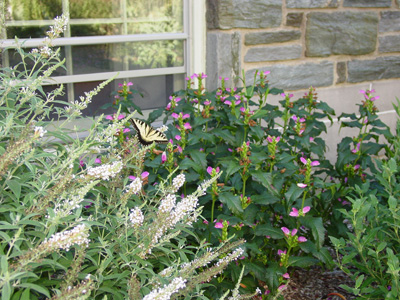 Plenty of species, not just your human neighbors, are intrigued by what you plant in your landscape. There is a growing awareness that we should consider their interest and provide food and habitat for insects, birds, and other wildlife when making our plant selections. Doug Tallamy and others have alerted us to the particular value of incorporating native plants and plants for birds, insects, and pollinators in our backyards.
Plenty of species, not just your human neighbors, are intrigued by what you plant in your landscape. There is a growing awareness that we should consider their interest and provide food and habitat for insects, birds, and other wildlife when making our plant selections. Doug Tallamy and others have alerted us to the particular value of incorporating native plants and plants for birds, insects, and pollinators in our backyards.
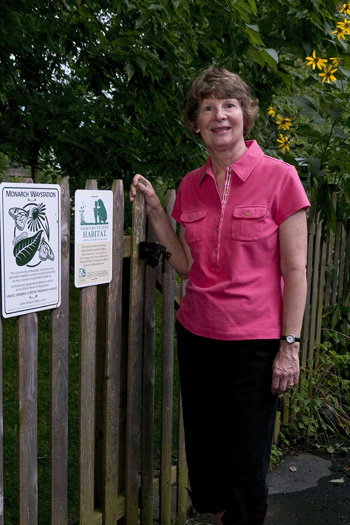
Barb Elliot's yard has been a certified wildlife habitat since 1998. photo credit: T. Patterson
We asked Barb Elliot to highlight some plants ideal for our non-human neighbors. Barb is the co-founder of the Backyards for Nature program at the Valley Forge Audubon Society. Active in several Philadelphia-area conservation groups, Barb is a trained “Habitat Steward” by the National Wildlife Federation, and her yard has been a certified wildlife habitat since 1998.
Barb bases her plant selections on a strict interpretation of “native”—giving the highest priority to plants she knows are indigenous to Southeast Pennsylvania and the Piedmont area. As an avid bird-watcher, her comments are a result of many hours of observation of animals and insects. Barb’s recommendations include:
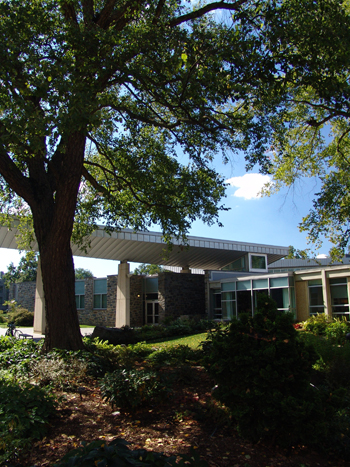
Betula nigra provides shade for the Harry Wood Garden. photo credit: R. Maurer
Betula nigra. I have grown three river birches in my yard. They grow quickly, and serve as great hosts for leaf-eating insects while maintaining an attractive presence in the garden.
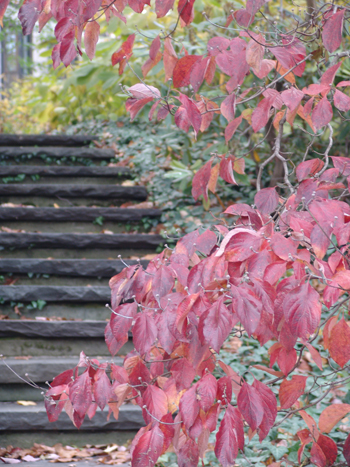
The attractive fall color of Cornus florida. photo credit: R. Robert
Everybody knows the flowers of our native dogwood, Cornus florida, but we should also remember the value of the red berries for migrating birds. Dogwoods are hosts for a number of butterfly and moth caterpillars, including spring azure butterflies and the cecropia moth, our largest native moth.
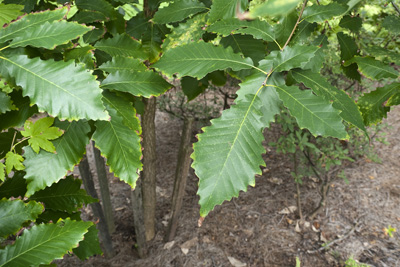
The leaves of Quercus muehlenbergii, the Chinkapin oak, seen here, are said to remind one of the Chestnut (Castanea dentate). However, blight has largely robbed us of seeing Chestnuts. Q. muehlenbergii leaves are also similar to the Chestnut oak (Quercus prinus), but shiny, more narrow, and sharply toothed. Find it at the Scott plant sale, because it is very uncommon in commercial trade. photo credit: T. Patterson
Although I don’t have Quercus muehlenbergii, I do know that everyone should have an oak. Oaks are at the absolute top of Doug Tallamy’s value list—supporting some 534 species of butterfly and moth caterpillars. These insects are a key food source for migrating birds, and offer acorns for birds and other animals. Bird-watchers tell you, “If you want to see spring migrating warblers, look in oaks.”
Most people probably think about Vaccinium, the blueberries, for dessert, but remember it’s a wonderful multi-use native plant. We have a blueberry hedge along our back fence, and tons of bees are among the flowers. The foliage is a food source for several butterfly species. The reality is, whatever our measures, we’re likely going to be sharing those blueberries with the birds. Netting is dangerous to birds—something I won’t do, and I just expect to share.
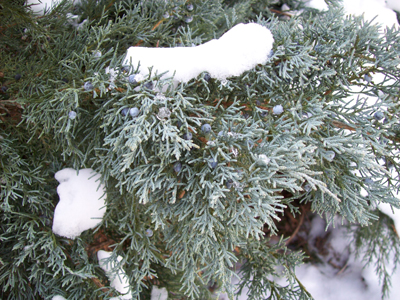
Juniperus virginiana 'Grey Owl' dabbled in snow. photo credit: J. Coceano
Speaking of berries, I now have eight Juniperus virginiana in my yard. The Eastern red cedar is fabulous cover for birds, plus many species nest in them. Last winter, I found a screech owl roosting in one of my trees. The little blue berries on the females are a significant food source, with some 54 bird species eating the fruit. The plant is also a larval food for the juniper hairstreak butterfly.
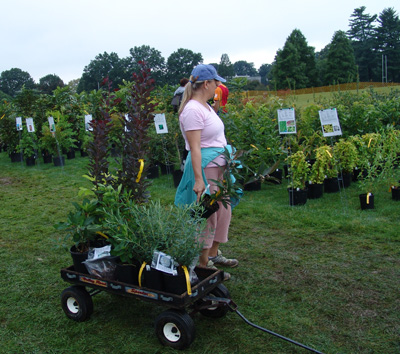
Discovering great plants at the Scott Assoicates Plant Sale. photo credit: J. Goren
All of the aforementioned plants will be available at the 2011 Scott Associates Plant Sale. Nearly one-third of the plants offered—both the woody shrubs and trees and the herbaceous perennials—are native to the eastern U.S.
These plants have selected because they are adapted to soil and weather conditions in Delaware County. They are low maintenance, energy-savers—needing less water and fertilizer than many other plants. And more, important, they provide food and shelter for birds, butterflies, pollinators, and other beneficial fauna, which have evolved over millennia expecting the seeds, berries and pollen from these co-inhabitants.
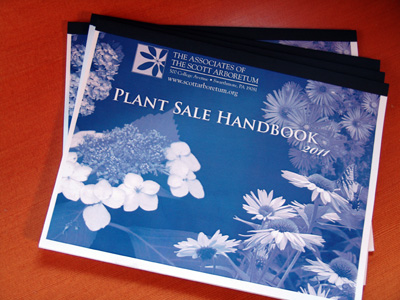
2011 Scott Associates Plant Sale Handbook. photo credit: R. Robert
You can get complete descriptions and cultural information about the plants Barb mentioned from the Plant Sale Handbook.
For a complete list of native plants available see page 53 in back of the handbook. For your convenience, we’ve reprinted it as a one-page list here.
Subscribe to Garden Seeds to read about Barb’s perennial plant recommendations and selection criteria for wildlife and conservation plants in our next post. Read more about planting for birds, insects, and pollinators in the Fall 2011 issue of the Hybrid. Laura Stiebitz discussing how the Scott Arboretum’s Pollinator Garden became a certified wildlife habitat with the National Wildlife Federation.
==================== >< ===================
Barb Elliot, Ph.D. in Educational Psychology, trained as a reading specialist, worked for GE Aerospace, retired from market research at AstraZeneca, and lives in Wayne, PA.
Ted Patterson, from Wayne, PA, retired from public relations work with the U.S. Dept. of Agriculture, is a co-chair of the woody plant section at the 2011 Scott Associates Plant Sale.





No Comments